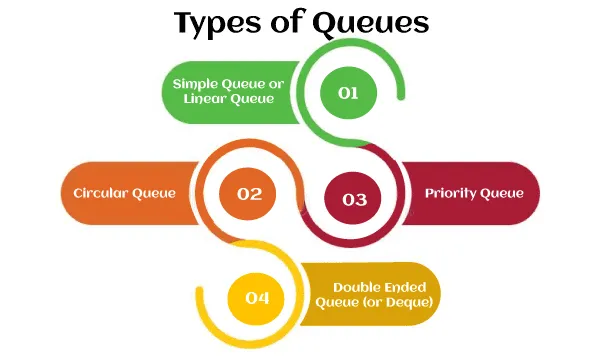In the realm of computer science, managing and organising data efficiently is the most challenging part. Data structures are the foundational blueprints that dictate how information is stored and accessed. Among these, the Queue Data Structure stands out for its simplicity and its resemblance to real-world applications. In this blog, let’s delve into the various types of queues, with examples and explore some of the applications of queues in Data Structures.
Understanding the Queue Data Structure:
Queue data structure definition: Queue data structure is a fundamental linear collection of data in a particular sequence of operations.
It follows the basic First In, First Out (FIFO) principle, which means the first element added to the queue is the first to be eliminated. It can be understood with a simple example of
For instance, customers standing in a line to pay at grocery shop. The first person to stand in line is to pay the bill first.

Let’s see some fundamental operations of queue data structure
- Enqueue: It adds elements to the queue.
- Dequeue: This removes elements from the queue.
- IsEmpty: Checks if the queue is empty.
- IsFull: This operation checks if the queue is full, as it is necessary to keep the queue open without any overflow of elements.
Now, let’s see how these operations work in different types of queue with examples
Types of Queues in Data Structures

- Simple Queue: The basic principle of FIFO(first in, first out) governs this kind of Queue Functions: elements added first are removed first.
Best example for simple queue is customers waiting in line to buy movie tickets, the first person in the queue receive the ticket first.
- Circular queue: A circular queue of data structure in which the last node or element is connected to the first node in a circle. This is to prevent overflow when the queue fills and to make effective use of the empty spaces in the queue.
For example, consider a circle of cars at a roundabout, where, when one car leaves, another comes in, and it carry so on.
This guarantees a travel free of traffic jams.
- Priority queue: Every time, the system allocates a priority to the queue elements and deques first the most important element.
Example: During an emergency in hospitals, regardless of the time they arrive, individuals with more critical conditions in the emergency room receive treatment first before those with less serious illnesses.
- Double-ended queue: This queue permits the adding and deleting of items from both the front and rear of the line. This is a flexible tool for various applications to be processed from both ends.
Example: You can add or remove any song from either side of your music playlist at any time. Creating a playlist the way you want is simple task with this operation.
Queue data structure algorithms make applications such as task management systems, data buffering, and process scheduling efficient.
Some more Applications of the Queue Data Structure:
As you have seen before, there are more applications of data structures. Queues have many uses in software systems, algorithms, and daily operations; they are not merely abstract ideas.
Queues are frequently utilised in:
Generally, organising, waiting, running, and ready processes known as process scheduling.
Handling interrupts: Keeping track of interruptions according to their arrival sequence.
2. Management of Data Streams
Queues serve as buffers when data is generated and consumed at varying rates. For instance:
the streaming data for videos.
and when using network routers to handle data packets.
3. Task Scheduling and Printing: Queues help facilitate the effective management of tasks sent to a printer or other execution device. The system processes tasks according to their priorities.
4. Web Server Request Management: Generally, web servers handle incoming client requests using a queue data structure. Therefore, the system processes the request one after the other, to ensure equitable and effective resource allocation.
5. Call Centres: Customer service call centres place incoming calls in a queue, until an operator becomes available. As it guarantees the system answers calls in order.
6. Traffic Management: Traffic signal system and other transport systems use queues to control traffic.
7. Banking Services: At bank branches, customers take a number and wait for their turn to get served.

8. E-commerce Order Processing: E-commerce platforms use queue data structure, from order processing, order receipt to payment processing, to shipment.
And in many cases, the queue data structure algorithm is ideal for real-world applications like process management, data stream processing, or task organisation. As it functions similarly to individuals waiting in a queue, the system performs tasks sequentially as they arrive.
Some Applications of the Queue Data Structure in Everyday Technologies
Let’s connect queues with familiar technologies you use daily:
- WhatsApp / Messenger: The system queues the messages before delivery to maintain order.
- Online Payments: System places transaction requests in queues before being processing securely.
- YouTube Buffering: The video queues frames for smooth playback.
- Operating Systems: The operating system queues background tasks like updates and any downloads based on priority.
- Queues are truly the invisible heroes behind modern computing experiences.
Advantages of the Queue data structure
- Orderly Processing: Maintains sequence integration in data or process handling.
- Efficient Resource Use: Especially in circular queues and deques.
- Smooth Task Management: Useful in asynchronous systems.
- Scalability: Performs admirably in settings with multiple users or threads
- The drawbacks of the queue in data structures
- Restricted Access: You can’t access random elements; you can only access the front or rear ones.
- Overflow and Underflow Problems: In array-based queues, improper handling might result in problems.
- Fixed Size (in arrays): Dynamic resizing can be complex.
However, these issues can be overcome.
Whereas, queue data structure algorithm in JavaScript is useful in handling asynchronous processes, user requests, and online application events. By studying these data structure implementations in various languages, you can absolutely gain a deeper knowledge of how queues function in real-world scenarios.
What are you waiting for
Take a hands-on software development course if you want to learn programming basics like queue data structure in JavaScript. For that the Software Development Program at Henry Harvin offers project-based learning that goes beyond theory.
Why choose Henry Harvin for the Queue Data Structure?

Henry Harvin provides many industry-aligned courses. It is a well-known institution for providing online courses. Their software development programs help students build the essential coding skills, confidence, and adaptability. The certifications and accreditation of the platform make the courses more authentic to pursue. It helps to succeed in programming and software Development by covering a variety of languages, data structures like queues in practical applications.
In order to give you real-world experience in addition to academic knowledge, the course also emphasises problem-solving and small project creation. By the end, you will be work ready, and can use the queue data structure in different languages confidently. Regardless of your career goals, this course equips you to manage projects efficiently and become a well coding developer.
Conclusion
Even though they might appear trivial at first, queues are essential to software development and programming. By combining theory with practical application, you can become a true expert in queue data structures in JavaScript, Python C, C++, and other languages. Along with learning a concept you also need to develop practical skills to solve common coding issues, write effective programs, and advance your programming career.
Equip yourself with essential queue concepts—start your Coding Course now with Henry Harvin and excel! Contact us at Henry Harvin Course Inquiry
Recommended Pages
- Application Software: Types & Benefits
- What is Database Testing and How to Perform it?
- Top 10 DevOps Engineer Skills you Should Know
- Scope of Software Testing Courses in 2025
Frequently Asked Questions
Browser history, printer, functional call stack and backtracking.
Ticket counters, airport security checks, ATM machines are some examples.
Process or task management, inter-process communication are some technical applications of queue.
It can be implemented in arrays and linked list.
As circular queues reuse memory efficiently, avoiding wastage.






Recent Comments